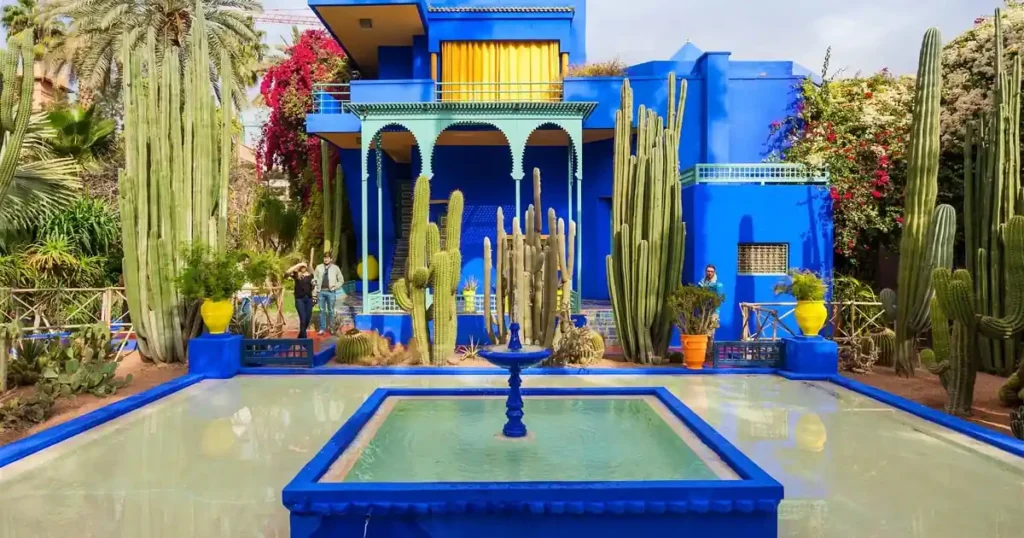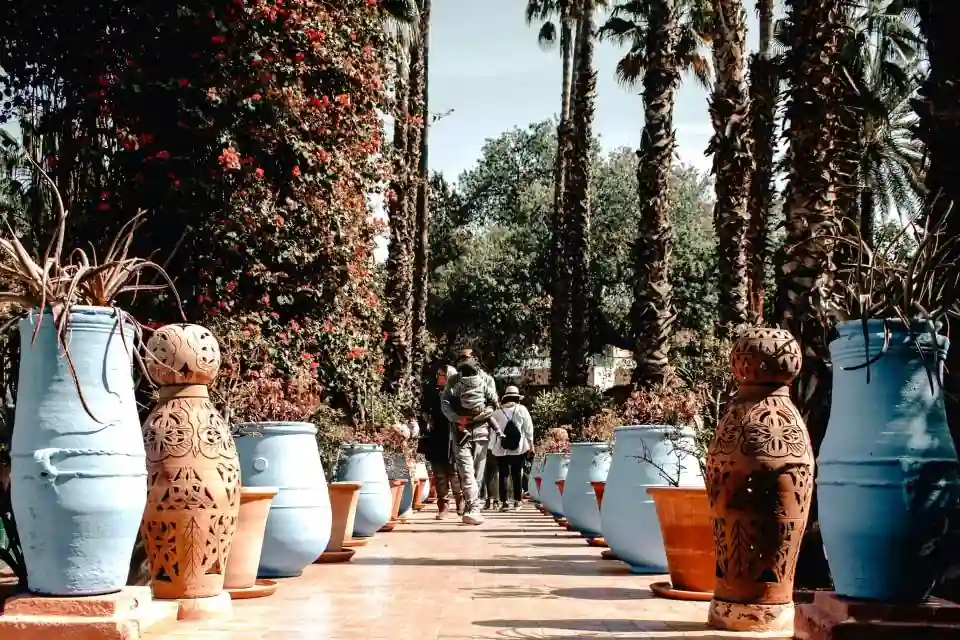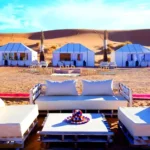Table of Contents
Introduction to Majorelle Garden Marrakech
Nestled amidst the vibrant city of Marrakech, Morocco, lies a haven of exotic beauty and captivating history: the Majorelle Garden Marrakech & Pierre Bergé Berber Art Museum. This enchanting site isn’t simply a garden or a museum; it’s a tapestry woven from vibrant colors, rich cultural heritage, and artistic passion, offering a unique and unforgettable experience for all who visit.
Step through the cobalt-blue gates of the Majorelle Garden and prepare to be transported to a world of enchantment. Lush greenery bursts forth from meticulously sculpted pathways, vibrant bougainvillea cascades over sun-drenched walls, and the air hums with the melody of trickling fountains and exotic birdsong.
This captivating oasis is more than just a visual feast; it’s a testament to the artistic vision of several passionate individuals who have shaped its history over the past century. From the creative genius of its initial designer to the visionary patronage that ensured its preservation, the Majorelle Garden’s tale is one of artistic inspiration, cultural dedication, and the enduring power of beauty.

The History of the Majorelle Garden
The story of the Majorelle Garden begins in the early 20th century with the arrival of French painter Jacques Majorelle. Captivated by the vibrant colors and rich culture of Morocco, Majorelle purchased a neglected piece of land in 1923 and embarked on an ambitious project: to create a botanical sanctuary infused with his artistic sensibilities.
Over the next 20 years, Majorelle poured his creative energy into the garden. He meticulously designed winding pathways, planted lush exotic flora, and constructed captivating structures, all infused with his signature Art Deco style. The now-iconic cobalt blue hue, known as “Majorelle blue,” became a defining element of the garden, adorning walls, planters, and even the Berber-inspired cubist villa at its heart.
In 1937, Majorelle tragically passed away, leaving his beloved garden incomplete. However, his legacy was soon taken up by another artistic visionary: Yves Saint Laurent. In 1962, Saint Laurent and his partner Pierre Bergé purchased the property, recognizing its immense artistic and cultural value.
Under their care, the Majorelle Garden blossomed anew. Saint Laurent, captivated by its colors and serenity, found inspiration for his fashion designs within its tranquil embrace. Meanwhile, Bergé embarked on a mission to preserve the garden and share its beauty with the world.
In 1984, Bergé established the Pierre Bergé Museum of Berber Arts within the former Majorelle studio. This museum houses a rich collection of Berber artifacts, showcasing the vibrant artistry and cultural heritage of Morocco’s indigenous people. From intricate jewelry and textiles to traditional instruments and everyday objects, the museum paints a captivating portrait of Berber life and traditions.
Today, the Majorelle Garden & Pierre Bergé Berber Art Museum stands as a testament to the enduring power of art and cultural appreciation. It serves as a vibrant oasis in the heart of Marrakech, welcoming visitors from all corners of the globe to experience its unique blend of botanical beauty, artistic inspiration, and rich cultural heritage.
The Majorelle Garden Marrakech Today
Step through the cobalt blue gates and prepare to be embraced by a vibrant tapestry of color and tranquility. Lush greenery explodes from meticulously sculpted pathways, casting cool shadows against sun-drenched walls adorned with cascading bougainvillea in a riot of magenta, orange, and purple. The air hums with the melody of trickling fountains and exotic birdsong, creating a symphony of natural harmony.
Wander through the labyrinthine paths, discovering hidden pools reflecting the cerulean sky, charming bridges crossing koi-filled ponds, and tranquil courtyards bathed in dappled sunlight. Cactus gardens erupt in a spiky ballet of green shapes, while fragrant palm trees whisper secrets in the breeze.
At the heart of the garden lies the iconic cubist villa, its cobalt blue walls contrasting dramatically with the vibrant greenery. Designed by Majorelle in collaboration with architect Paul Sinoir, the villa is a stunning fusion of Berber and Art Deco styles, adorned with geometric motifs and colorful tiles. Inside, a small museum showcases some of Majorelle’s paintings and personal effects, offering a glimpse into the creative mind that birthed this enchanting oasis.
Take a moment to pause beside the reflecting pool, its mirror-like surface capturing the kaleidoscope of colors surrounding you. Breathe in the heady scent of jasmine and citrus trees, letting the tranquility of the garden wash over you. Here, amidst the vibrant hues and lush greenery, time seems to slow down, allowing you to reconnect with nature and your inner peace.
The Majorelle Garden is more than just a botanical haven; it’s a living piece of art, a testament to Majorelle’s vision and the love and dedication of those who have preserved it. Whether you’re an art enthusiast, a nature lover, or simply seeking a moment of serenity, this enchanting oasis offers an unforgettable experience for all.
The Pierre Bergé Museum of Berber Art in the Majorelle Garden

Housed within the former studio of Jacques Majorelle, the Pierre Bergé Museum of Berber Art offers a window into the rich cultural heritage of Morocco’s indigenous Berber people. Stepping through the arched doorway, you’re transported to a world of intricate craftsmanship and vibrant traditions.
Over 600 artifacts are meticulously displayed, each one a testament to the skill and creativity of Berber artisans. Dazzling silver jewelry adorned with geometric patterns shimmers beneath the soft lighting, while intricately woven carpets tell stories of nomadic life and tribal symbols. Traditional instruments like lutes and drums hint at vibrant musical traditions, while everyday objects like bowls, jugs, and cooking utensils showcase the practicality and beauty of Berber craftsmanship.
Explore the collection and discover the diversity of Berber cultures across Morocco. Immerse yourself in the rich symbolism woven into textiles, marvel at the ingenuity of everyday objects, and appreciate the delicate artistry of jewelry passed down through generations.
The museum also features temporary exhibitions delving deeper into specific aspects of Berber culture, from traditional wedding rituals to the history of Berber tattooing. Educational workshops and film screenings offer further opportunities to learn and engage with this fascinating culture.
Leaving the museum, you carry with you not just knowledge of Berber culture, but also a newfound appreciation for the beauty and resilience of a people who have thrived for centuries amidst the unforgiving landscapes of Morocco. The Majorelle Garden & Pierre Bergé Berber Art Museum is a testament to the enduring power of art, culture, and nature, offering a vibrant tapestry of beauty and knowledge for all who visit.
How to Visit the Majorelle Garden Marrakech
Planning your visit to the Majorelle Garden & Pierre Bergé Berber Art Museum is an exciting step in experiencing this enchanting oasis. Here’s what you need to know:

Planning your trip:
- Timing: The garden is open daily from 8:30 AM to 6:00 PM, with the last entry at 5:30 PM. The Berber Museum opens slightly later at 9:00 AM and closes at 5:30 PM, with the last entry at 5:00 PM.
- Tickets: To avoid disappointment and ensure your preferred entry time, purchasing tickets online in advance is highly recommended. You can do so through the official website: https://tickets.jardinmajorelle.com/
- Getting there: The Majorelle Garden is conveniently located in the Gueliz district of Marrakech, easily accessible by taxi or on foot from the medina.
- What to wear: Dress comfortably for walking on uneven pathways and consider sun protection as the garden receives plenty of sunshine.
Enhancing your experience:
- Guided tours: Opt for a guided tour in English or French for a deeper understanding of the garden’s history, architecture, and botanical significance.
- Audio guide: Rent an audio guide for a self-guided exploration at your own pace. Available in several languages, it provides insightful commentary on the garden’s highlights.
- Cafe Majorelle: After exploring the garden, take a break at the charming Cafe Majorelle. Nestled under the shade of palm trees, the cafe offers refreshing drinks and light meals.
- Souvenir shop: Browse the selection of Berber-inspired crafts and art books at the on-site shop to take a piece of the Majorelle magic home with you.
Remember:
- Respect the tranquility of the garden by speaking softly and being mindful of other visitors.
- Photography is permitted for personal use, but avoid using flash and tripods.
- Drones are strictly prohibited within the garden grounds.
Conclusion
The Majorelle Garden & Pierre Bergé Berber Art Museum is more than just a tourist destination; it’s a sensory feast, a cultural immersion, and a testament to the power of artistic vision. From the vibrant explosion of colors in the garden to the intricate artistry of Berber artifacts, this Marrakech gem offers an unforgettable experience for every visitor.
Whether you’re seeking a moment of serenity amidst lush greenery, a journey into the heart of Berber culture, or simply inspiration from a place steeped in artistic history, the Majorelle Garden awaits. So step through the cobalt blue gates, lose yourself in its vibrant embrace, and let this enchanting oasis weave its magic on you.
Remember, the true beauty of the Majorelle Garden lies not just in its sights and sounds, but in the emotions it evokes, the memories it creates, and the inspiration it fuels. So prepare to be captivated, enchanted, and forever changed by the magic of this Moroccan oasis.
I hope this comprehensive guide helps you plan your visit to the Majorelle Garden & Pierre Bergé Berber Art Museum and leaves you yearning to experience its magic firsthand!







